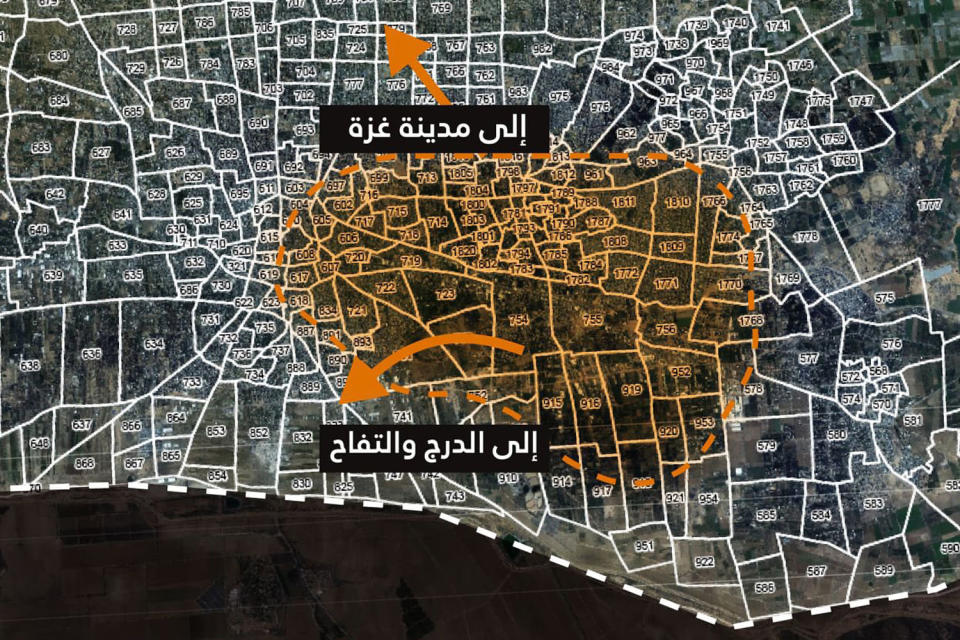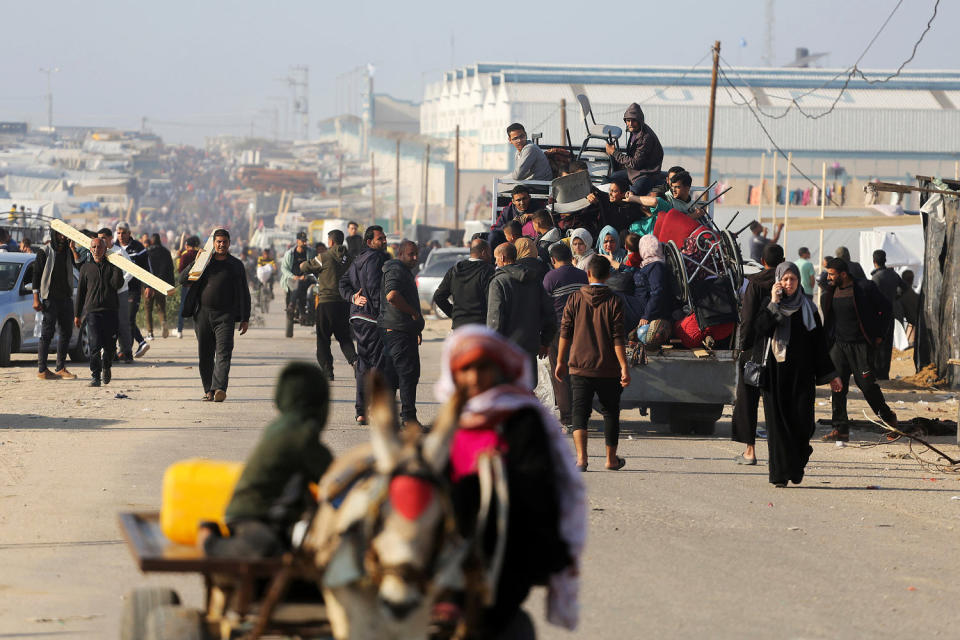Israel's new grid maps add to confusion and anger in Gaza
Facing mounting pressure to lessen Palestinian civilian suffering, Israel has combined its assault on the southern Gaza Strip with an online map dividing the enclave into hundreds of zones, which it says will direct residents to safe areas away from its fight against Hamas.
However, this grid-based map has been derided by international aid agencies and people in Gaza. They say it is a confusing system that many inside the densely populated strip will be unable to access because of the intermittent electricity and internet coverage.
Furthermore, Palestinians and international observers of Israel’s aerial and ground operation say that — with or without a map — nowhere in this heavily bombarded and besieged enclave is safe.
“The map isn’t usable because the communications are really, really bad,” Mohammad Ghalayini, who lives in the southern Gaza city of Khan Younis, told NBC News.

Ghalayini has already had to move five times during the current conflict, leaving Gaza City in the north for Khan Younis in the south, in an exodus urged by Israel and repeated by thousands of the enclave’s residents. Now, Israeli tanks and troops are once again targeting the city in which he has sought refuge — and to the 44-year-old, who said he found the map low-resolution and confusing on his internet connection, this is more about shaping international opinion than the safety of Gazans themselves.
“It’s a PR stunt that pays lip service to the idea of civilian protection,” said Ghalayini, who used to work as an air quality scientist before the conflict, “so then U.S. politicians can point to the map and say: ‘Look Israel is doing everything it can.’”
The White House has indeed become one of the loudest voices urging Israel to do more to limit displacement and deaths during its renewed assault on Gaza. Almost 16,000 people have been killed since the war began, around 70% of them women and children, according to local officials whose figures are supported by U.S. and United Nations officials.
Israel’s government and military say they are targeting only Hamas, which carried out the Oct. 7 attack in which 1,200 people were killed and some 240 abducted, according to Israeli officials. Israel blames Hamas, which runs Gaza, for using civilians as “human shields” and the Israeli military says it’s doing everything it can to protect civilians.
On Friday, the Israel Defense Forces published an online map showing Gaza — a tiny territory around twice the size of Washington, D.C. — split up into more than 600 zones, some no more than a block or two in size. The map itself doesn’t contain any interactive information, but rather the Israeli military says that Gazans should cross-reference its grid numbers with updates given through its Arabic language accounts on X about which zones they should evacuate.
That requires not only enough power and internet to access the map, but also for Palestinians under heavy bombardment to keep up with social media, too. And on Monday, when the IDF’s Arabic spokesperson, Avichay Adraee, told people that “we invite you to move” out of several numbered neighborhoods, the corresponding infographic he posted did not match up with his written message.
Nevertheless, the Israeli military dropped leaflets containing QR codes that linked to the map. And on Tuesday, it said 250,000 people had accessed the webpage so far.
“The map is divided into neighborhood numbers, indicating where civilians in a specific area should go to avoid being in the crossfire,” IDF spokesman Daniel Hagari told a news briefing Monday. “We call on international organizations in Gaza to assist us with this effort. It can help save lives.”


'No place is safe'
Several of these worldwide groups have disagreed, however.
Asked whether Israel’s map could be useful, Juliette Touma, director of communications of the U.N.’s Palestinian relief agency, gave a flat rejection of its premise.
“No place is safe across the Gaza Strip including the south,” she told NBC News in an email. “During this war, no civilian infrastructure or facility has been spared, including hospitals, medical facilities, schools, and U.N. shelters.”
Another senior U.N. official, UNICEF spokesman James Elder, told a news briefing via video link Tuesday that “the so-called safe zones … are not scientific, they are not rational, they are not possible, and I think the authorities are aware of this.”
The London-based charity Medical Aid for Palestinians posted on social media that the map had “left people guessing which square will save their lives.”
Israel says it’s doing everything possible to protect civilians, including telling people living in northern Gaza to move south at the start of the conflict and away from the initial focus of its fighting. That prompted a mass exodus, and, humanitarian groups say, a worsening of the humanitarian crisis in this cramped territory.
A weeklong pause in the fighting saw some 100 hostages freed from Gaza in exchange for around 240 Palestinian prisoners held in Israeli jails. When the pause ended, Palestinians in Gaza were asked to move again, with residents in the city of Khan Younis, many of whom were displaced from elsewhere, told to make another southward journey, this time to Rafah on the Egypt border.
When asked about the criticism the maps have received, the IDF pointed to an interview between one of its spokespeople, Maj. Doron Spielman, and NBC News’ British partner, Sky News.
Spielman referred to a video last week showing Hamas leading hostages through Gaza about to be freed, and “hundreds of Gazans holding their phones videoing them.”
He said, “Clearly there’s enough power to power their phones when they are parading our hostages through Gaza. Now that same power to their phones will be [needed] to get the maps, download the maps and look at the flyers.”
An IDF spokesperson also told NBC News that it was using other methods to warn residents, such as calling and texting to urge them to leave their homes.
For some inside Gaza, all the warnings in the world would be no justification for forcing them to flee their homes.
“If people don’t leave, does that make them fair game?” Ghalayini asked. “The thing Israel needs to do to protect civilians is simple — it must stop its brutal assault.”
This article was originally published on NBCNews.com

